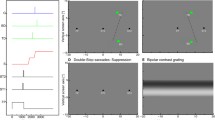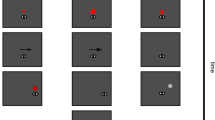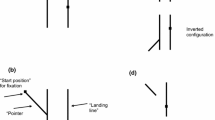Abstract
It is nowadays generally recognized that saccades to remembered targets are planned in a craniotopic frame of reference by combining retinal input with eye position signal. The origin of the eye position signal is still a matter of controversy, however. Does it arise from an efferent copy or is it supplied by the sensory receptors with which the extraocular muscles are endowed? When applied to skeletal muscles, vibration elicits spindle responses simulating a stretching of the vibrated muscle. When vibration is applied to the inferior rectus muscle (IR), it induces the illusion that a stationary fixating point is moving upward. Here we attempted to change the initial eye position signal supplied to the oculomotor system before a memory- or visuo-guided saccade to a 10° left target by applying mechanical vibration to the IR muscle. We wanted to determine whether modifying extraocular proprioceptive cues during the programming phase of a saccade might affect the latter's trajectory. In the memory-guided condition, it was observed that the saccades ended lower down when vibration was applied than in the control condition. Conversely, the visuo-guided saccades were not affected by the vibration. The above results mean first that extraocular proprioceptive cues are used as an initial eye position signal when a memory guided saccade has to be planned. Secondly, they suggest that extraocular proprioception may not be used to produce a visuo-guided saccade, or that this type of saccade is computed solely on the basis of retinal cues.
Similar content being viewed by others
References
Becker W (1991) Saccades. In: Carpenter RHS (ed) Eye movements. Macmillan, London, pp 95–117
Becker W, Jürgens R (1979) An analysis of the saccadic system by means of double step stimuli. Vision Res 19: 967–983
Bridgeman B, Stark L (1991) Ocular proprioception and efference copy in registering visual direction. Vision Res 31: 1903–1913
Bridgeman B, Lewis S, Heit G, Nagle M (1979) Relation between cognitive and motor oriented systems of visual position perception. J Exp Psychol Hum Percept Perform 5: 692–700
Buisseret P (1995) Influence of extraocular muscle proprioception on vision. Physiol Rev 75: 323–338
Buisseret P, Maffei L (1977) Extraocular proprioceptive projections to the visual cortex. Exp Brain Res 28: 421–425
Donaldson IML, Long AC (1980) Interactions between extraocular proprioceptive and visual signals in the superior colliculus of the cat. J Physiol (Lond) 298: 85–110
Droulez J, Berthoz A (1991) A neural network model of sensori- topic maps with predictive short-term memory properties. ProNatl Acad Sci USA 88: 9653–9657
Gauthier GM, Nommay D, Vercher JL (1990) The role of ocular muscle proprioception in visual localization of targets. Science 249: 58–61
Gilhodes JC, Gurfinkel VS, Roll JP (1992) Role of Ia muscle spindle afferents in post-contraction and post-vibration motor effect genesis. Neurosci Lett 135: 247–251
Gnadt JW, Bracewell RM, Andersen RA (1991) Sensorimotor transformation during eye movements to remembered visual targets. Vision Res 31: 693–715
Guthrie BL, Porter JD, Sparks DL (1983) Corollary discharge provides accurate eye position information to the oculomotor system. Science 221: 1193–1195
Hallet PE, Lightstone AD (1976) Saccadic eye movements towards stimuli triggered by prior saccades. Vision Res 16: 99–106
Honda H (1990) The extraretinal signal from the pursuit-eye-movement system: its role in the perceptual and the egocentric localization systems. Percept Psychophys 48: 509–515
Israël I (1992) Memory-guided saccades: what is memorised? Exp Brain Res 90: 221–224
Jürgens R, Becker W, Kornhuber HH (1981) Natural and drug-induced variations of velocity and duration of human saccadic eye movements: evidence for a control of the neural pulse generator by local feedback. Biol Cybern 39: 87–96
Lewis RF, Zee DS (1993) Abnormal spatial localization with trigeminal-oculomotor synkinesis. Brain 116: 1105–1118
Lukas JR, Aigner M, Blumer R, Heinzl H, Mayr R (1994) Number and distribution of neuromuscular spindles in human extraocular muscles. Invest Ophthalmol Vis Sci 35: 4317–4327
Mays LE, Sparks DL (1980) Saccades are spatially, not retinocentrically, coded. Science 208: 1163–1165
Miller JM (1980) Information used by the perceptual and oculomotor systems regarding the amplitude of saccadic and pursuit eye movements. Vision Res 20: 59–68
Robinson DA (1973) Models of the saccadic eye movement control system. Kybernetik 14: 71–83
Roll JP, Vedel JP (1982) Kinaesthetic role of muscle afferents in man, studied by tendon vibration and microneurography. Exp Brain Res 47: 177–190
Roll R, Velay JL, Roll JP (1991) Eye and neck proprioceptive messages contribute to the spatial coding of retinal input in visually oriented activities. Exp Brain Res 85: 423–431
Schlag J, Schlag-Rey M, Dassonville P (1989) Interactions between natural and electrically evoked saccades. II. At what time is eye position sampled as a reference for the localisation of a targe. Exp Brain Res 76: 548–558
Sodi A, Corsi M, Faussone Pellegrini MS, Salvi G (1988) Fine structure of the receptors at the myotendinous junction of human extraocular muscles. Histol Histopath 3: 103–113
Steinbach MJ (1987) Proprioceptive knowledge of eye position. Vision Res 27: 1737–1744
Tweed DB, Vilis T (1985) A two dimensional model for saccade generation. Biol Cybern 52: 219–227
Van Gisbergen JAM, Robinson DA, Gielen S (1981) A quantitative analysis of generation of saccadic eye movements by burst neurons. J Neurophysiol 45: 417–442
Velay JL, Roll R, Lennerstrand G, Roll JP (1994) Eye proprioception and visual localization in humans: influence of ocular dominance and visual context. Vision Res 34: 2169–2176
Velay JL, Roll R, Demaria JL, Bouquerel A, Roll JP (1995) Human eye muscle proprioceptive feedback is involved in target velocity perception during smooth pursuit. In: Findlay JM. Walker R, Kentridge RW (eds) Eye movement research: mechanisms, processes and applications. Elsevier Science, Amsterdam, pp 79–85
Viviani P, Velay JL (1987) Spatial coding of voluntary saccade in man. In: O'Regan JK, Lévy-Schoen A (eds) Eye movements: from physiology to cognition. Elsevier/North Holland, Amsterdam, pp 69–78
White JM, Sparks DL, Stanford TR (1994) Saccades to remembered target locations: an analysis of systematic and variable errors. Vision Res 34: 79–92
Author information
Authors and Affiliations
Rights and permissions
About this article
Cite this article
Allin, F., Velay, J.L. & Bouquerel, A. Shift in saccadic direction induced in humans by proprioceptive manipulation: a comparison between memory-guided and visually guided saccades. Exp Brain Res 110, 473–481 (1996). https://doi.org/10.1007/BF00229147
Received:
Accepted:
Issue Date:
DOI: https://doi.org/10.1007/BF00229147




